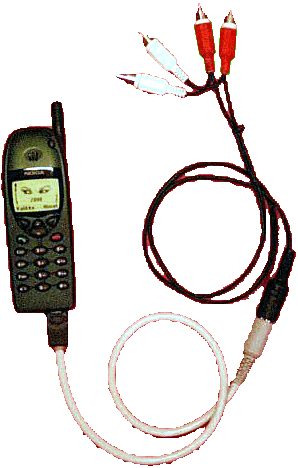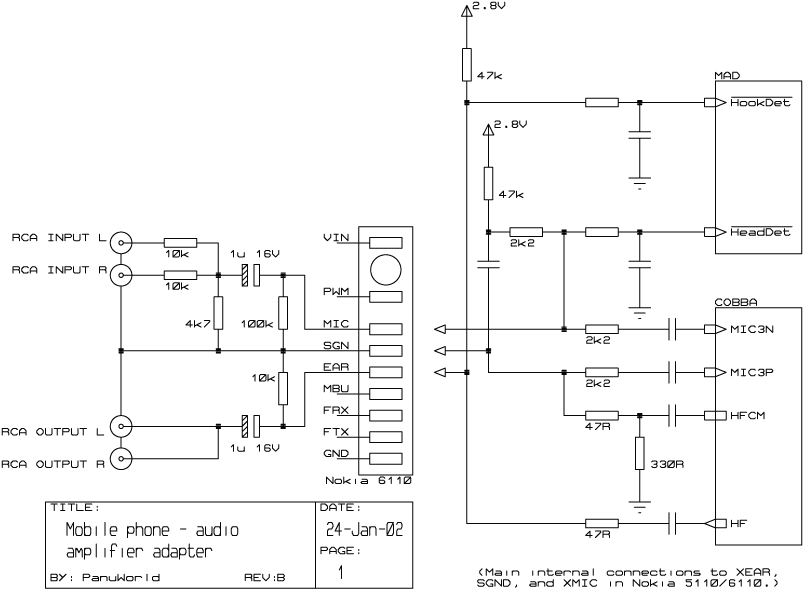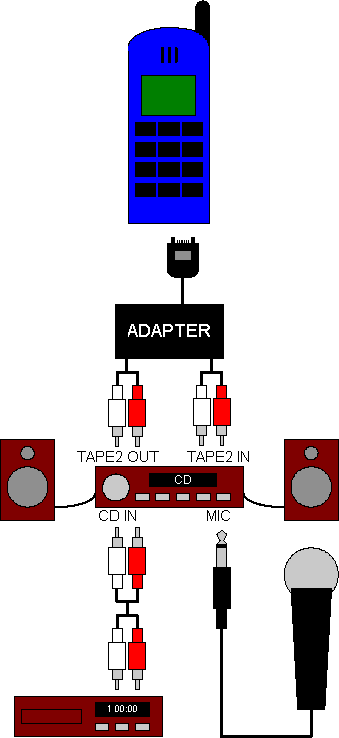
 |
||||||
| HARDWARE | DOWNLOADS | MISCELLANEOUS | ||||
 |
||
 NuukiaWorld project:
NuukiaWorld project:This document describes an example of adapter between a Nokia 5110/6110 series phone and an audio amplifier/preamplifier (and usually a mixing device) with standard line inputs and outputs. The adapter device is then useful for recording calls, adding music on the line and listening to the calls via speakers. This adapter may be used also to connect the phone to the audio card of a PC.
WARNING! Although the author has tested these circuits, no guarantee can be given for the operation or compatibility. If you do not understand the purpose of a single component in these circuits, do not build these devices. You are doing everything at your own risk.
The first revision of NuukiaWorld's audio adapter was based on headset concept. The phone detected the adapter as a headset and the audio signals were available at the system connector that way.
However, there is a better way to implement the audio adapter. It can be seen by studying the internal structure and operation of the audio interface in Nokia 5110/6110 series phones: By switching the phone into Car profile, the "COBBA" baseband audio ASIC in phone skips the preamplifier of the external audio input (XMIC) signal. This means that the phone accepts larger signal levels that way.
The previous revision of the audio adapter attenuated the
audio signal to the level of headset microphone signal. The COBBA
ASIC then amplified it back before AD conversion. This implementation
made the old revision more sensitive to (GSM) noise.
I have been told that at least the audio output works fine with
Nokia 9110 Communicator, too. But I am sorry, you need to find out the
Nokia 9110 pin-out by yourself.
The right part of Figure 1 is simplified schematic diagram of the phone external audio inputs. Only the audio lines used by the Car profile has been drawn. You can see that COBBA ASIC has a differential audio input MIC3 for the car kit HFU-2. COBBA uses the same single-ended output (HF/HFCM) for both headset and car kit.
Signaling is simple. By default, the XEAR pin of the phone is internally pulled up with 47 kilo-ohm resistor. The car kit pulls the pin down with a 10 kilo-ohm resistor that causes the HookDet of the processor ASIC "MAD" go down. Change at HookDet generates an interrupt in MAD and the phone switches to Car profile. (A headset pulls down the XMIC pin with the microphone itself and this causes MAD HeadDet input go low.)
The car kit must activate the car profile by pulling the XEAR down with a DC load. The XEAR carries also the output audio as an AC signal. At input pin XMIC, I have seen that the DC bias must be set so that the AC signal is properly transmitted into COBBA. On the other hand, too low DC level at XMIC causes HeadDet pin on MAD to go down and phone to activate the Headset profile.

The adapter circuit is shown to left from the Nokia 6110 system connector in figure 1. You can build the device into a separate box and use cables for the connectors or try to install the required components into the connector cases of RCA plugs and Nokia connector. NuukiaWorld soldered the components into connectors, so there is no circuit board design available.
The audio output XEAR (EAR, 5) of the phone is pulled down with a 10 kilo-ohm resistor. This load causes the processor in MAD to switch the phone into Car profile. The AC signal from XEAR is DC-blocked with a 1 µF capacitor (observe the polarity) and then connected to both output channels of the adapter.
The audio input is slightly more complicated. The stereo signals must be combined to a mono signal, the level must be lowered and the DC from the phone must be blocked. In addition, there must be suitable DC bias at the XMIC line, otherwise COBBA ASIC inputs will clip the AC audio signal.
The level and stereo signal problems are eliminated with a resistor divider of three resistors. The 1 µF capacitor is used to block the DC coming from the phone. XMIC DC bias is achieved by loading the pin with a 100 kilo-ohm resistor as the phone has about 50 kilo-ohm pull-up for the same pin.

The adapter is connected to a "TAPE2", "VCR", "DAT", or similar connectors of the source selector. In most cases it is important to be able to select the signal source of the phone input independently of the phone output signal which is directed to the amplifier and loudspeakers.
With the audio equipment I use, the adapter is connected to "TAPE2" sockets, and the source selector button "TAPE2/MONITOR" is selected (for loudspeaker output). In addition to this the other source selection buttons select the audio source of the phone inputs. Usually I select "CD". By using the microphone mixing function I can also mix my speech on the CD music when calling.
To record the calls, you may have to mix the incoming voice with the outgoing voice manually with a mixer before the recorder. In most cases the echo cancellation of the telephone connection is so good that the voice you send to the recipient is not sent back at all.
There is also third use for the adapter: Enable automatic answering and connect a phone with the adapter to an amplifier or other PA device. After that you can use any other mobile phone as a wireless microphone. Just take a mobile phone into hand, call to the phone staying at the amplifier and speak to the bottom end of your phone - this "wireless microphone" has unlimited working distance!
Note: If you connect the adapter to PC sound card, do not connect a data cable between the phone and PC simultaneously. Connecting both cables may result in poor sound quality and interference.
![]() © Copyright 1999,
2000, 2002 Panu Tuominen. All rights reserved. Republishing this
document partially or completely is forbidden. Internet hyperlinks
to this page are allowed and such linking is encouraged. You
are doing everything at your own risk. See the WARNING! in the
top of this page.
© Copyright 1999,
2000, 2002 Panu Tuominen. All rights reserved. Republishing this
document partially or completely is forbidden. Internet hyperlinks
to this page are allowed and such linking is encouraged. You
are doing everything at your own risk. See the WARNING! in the
top of this page.
The tests have been done with a Nokia 6110 phone. No exact information about compatibility with others is known. Timo Lindfors reported that at least the audio output works fine with Nokia 9110, too. (Nokia 9110 have different system connector and pin numbers.)
9.2.2004  nuukiaworld@gmail.com
nuukiaworld@gmail.com
No email support or answers to technical questions.